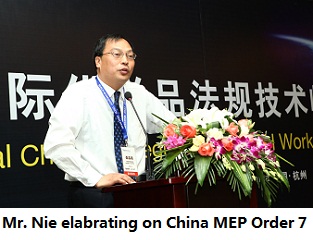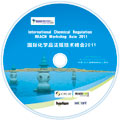7 December 2011
On the first day of the 2011 Workshop, Mr. Nie Jinlei, who is responsible for the management of China New Chemical Substances in CRC-MEP (Chemical Registration Center of Ministry of Environmental Protection) briefed on the current implementation of new chemical substance notification.
Statistics of the registration certificates
Up to now, only certificates for simplified notification (SN) and scientific research record (SR) have been issued by the MEP. On the first half of year 2011, 1570 registration certificates were released for the type of simplified notification and all of the registration certificates belong to the category of special cases under SN. These refer to certain special uses or properties of the registered substances, such as substance for the purpose of R&D, product research or process technology, for the sole purpose of export in tonnage of less than 1 t/y, intermediates, PLC, etc. For SN, special cases have generally less registration requirements than the general case. A breakdown of the specific registered type under SN is shown as the following table.
Status of simplified notification between January and June of 2011
|
Polymers with low monomer concentration (< 2% ) |
Polymers of low concern (PLCs) |
For purpose of product research or process technology |
For R&D purpose |
Intermediates |
For the sole purpose of exporting from China in quantities < 1 t/y |
|
1308 |
134 |
54 |
38 |
30 |
6 |
|
In total 1570 |
|||||
As for the registration of scientific research record, altogether 596 records were issued from November 2010 to the end of June 2011.
Post-registration management
Since the later half 2011, post-registration management of China REACH has been brought into the official agenda as more and more notifications are now under process in CRC-MEP. MEP Order No. 7 requirements on this part are embodied in information maintenance, communication and reporting. For certificate-holders, they need to keep a close eye on their tonnage or use change or modification. Delivering prompt first-time activity report to CRC-MEP is obliged to the company that registers a hazardous substance of priority environmental concern.
 1) The first-time activity report
1) The first-time activity report
According to Article 35 of MEP order No. 7, following manufacture or import, registration certificate holders of hazardous substances of priority environmental concern shall report the transfer information to the CRC each time these substances are transferred to different downstream users within 30 days of the transfers to each downstream user occurring.
This report has to contain information on the registration certificate number, method of transfer and transferred quantity; downstream user company name; address and contact person of the company; the communication of risk management measures etc.
At present, a group of certificate holders have submitted their first-time activity reports to the CRC-MEP following the instruction of CRC-MEP, Nie said on the 2011 workshop. When asked about the format and workability of the first activity report, Nie replied that companies could be assured that the format has taken into account of the needs and practice of extensive companies and the authority would sure help streamline office formalities for general notifiers.
2) On-site supervision and inspection from the authorities
The CRC-MEP visited two provinces of China to inspect the implementing status of IECSC supplementation (inclusion) and company notification practice in September and October this year. However, problems exposed in this inspection have led to the MEP decision of calling a halt to processing IECSC applications. Mr. Nie told the REACH24H workshop that required data for IECSC supplementation turned rather complicated and more than often it was difficult for CRC to determine the truthfulness of the application data submitted.
Mr. Nie also talked about main problems in the reviewing process of regular notification and simplified notification. He reminded companies of the following common mistakes in their notification dossiers:
Main problems in the reviewing Process of Regular notification:
1) Inconsistency in data between the notification form and test report;
2) Severe inadequate materials for notification;
3) Inappropriate classification of hazards, unidentified source of data used for classification;
4) Inappropriate risk characterization and related measures due to false classification of hazards;
5) Failure to identify the validity of data in the risk assessment report, use of unreliable data as basis for classification instead;
6) Failure to use all the known information in the risk assessment report;
7) Inaccurate estimation on emission and exposure in the risk assessment report, leading to inappropriate conclusion.
Main problems in the reviewing process of simplified notification:
1) Mistakes in chemical names such as wrong generic name or inconsistent Chinese name and English name;
2) Non-standard molecular formula or structural formula
3) Inconsistent data between the notification form and the test report;
4) Inadequate test data.









